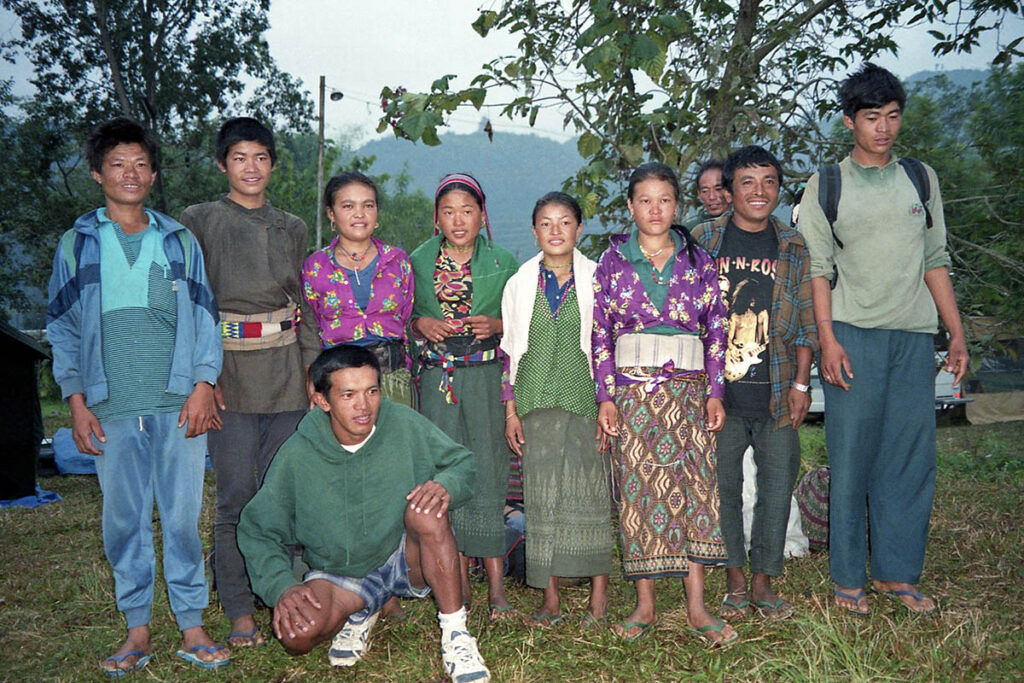Annapurna Dhaulagiri 14 day trek with World Expeditions – 26th October to 13th Novevember 1998 – visiting Pokhara, Landruk, Ghandruk, Tadapani, Do Bato, Christiburg, Kopra Ridge, Khayer Lake, Chitre, Ghorepani.
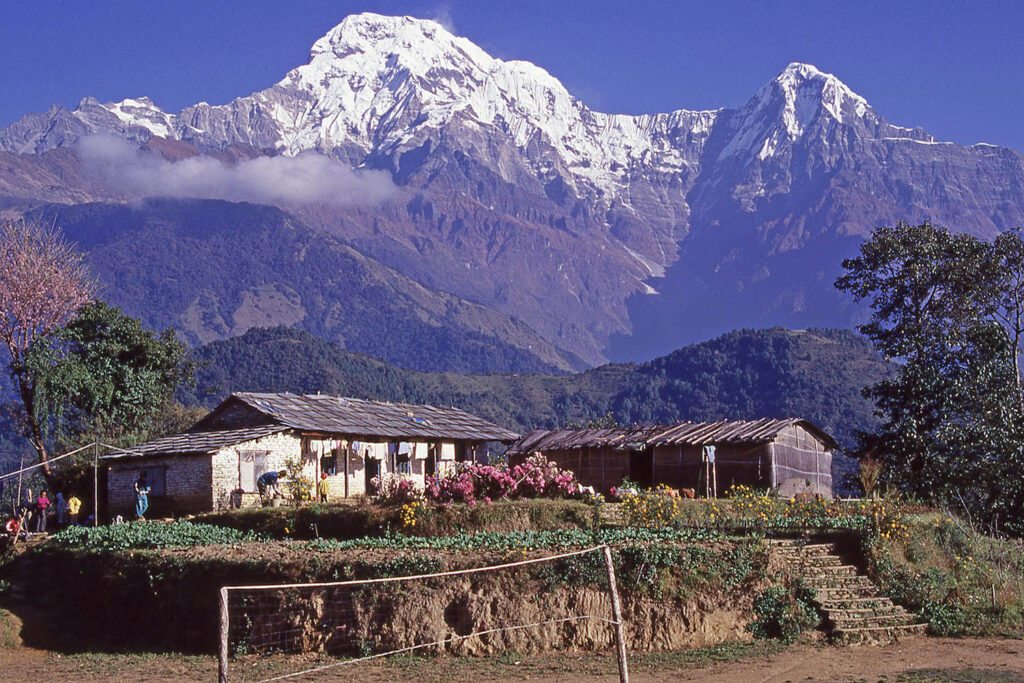
Well I made it back from my travels to Nepal and India relatively unscathed except for some weight loss. Incredibly, I did not get sick once during my 6 weeks in Nepal and India. Nepal was a great place to visit, a really magical place, friendly people, amazing scenery and I just loved trekking in the mountains, especially in the more remote trails. I stopped overnight in Bangkok on the way and the contrast between the two airports was amazing. With Bangkok you need a 10 minute bus ride to get to your plane. In Kathmandu the plane pulls up right next to the terminal, which is an old fashioned brick building. As soon as you exit the airport you are besieged by hawkers, guides and beggars. I have never seen such chaos outside an airport. A World Expeditions representative greeted us at the airport but we had to wait for an hour until they had found and assembled all the other clients.
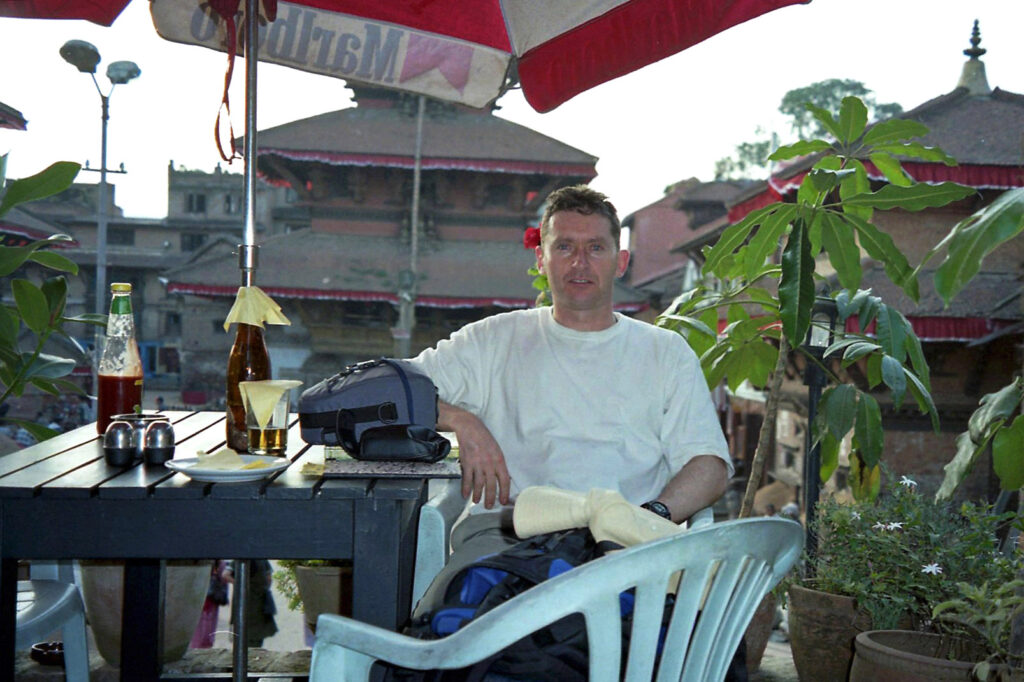
We had two nights at Kathmandu before the trek and we stayed at the Everest Hotel which was very luxurious with an old fashioned regal or colonial atmosphere with fancily dressed waiters and porters. They served up a huge buffet breakfast each morning so you could easily skip lunch. I did the usual touristy things in Kathmandu, such as visiting temples and the old cities like Patan and Bhaktapur. The pollution in Kathmandu was awful, thanks to the two stroke motor rickshaws, and you end up with a sore throat and eyes after a couple of days. We departed from our hotel in Kathmandu and had only just gone 500 metres up the road when I realised that I had left behind a small bag, so I yelled out to stop the bus. Luckily they stopped and I ran back and retrieved the bag. What a great start to the trip!
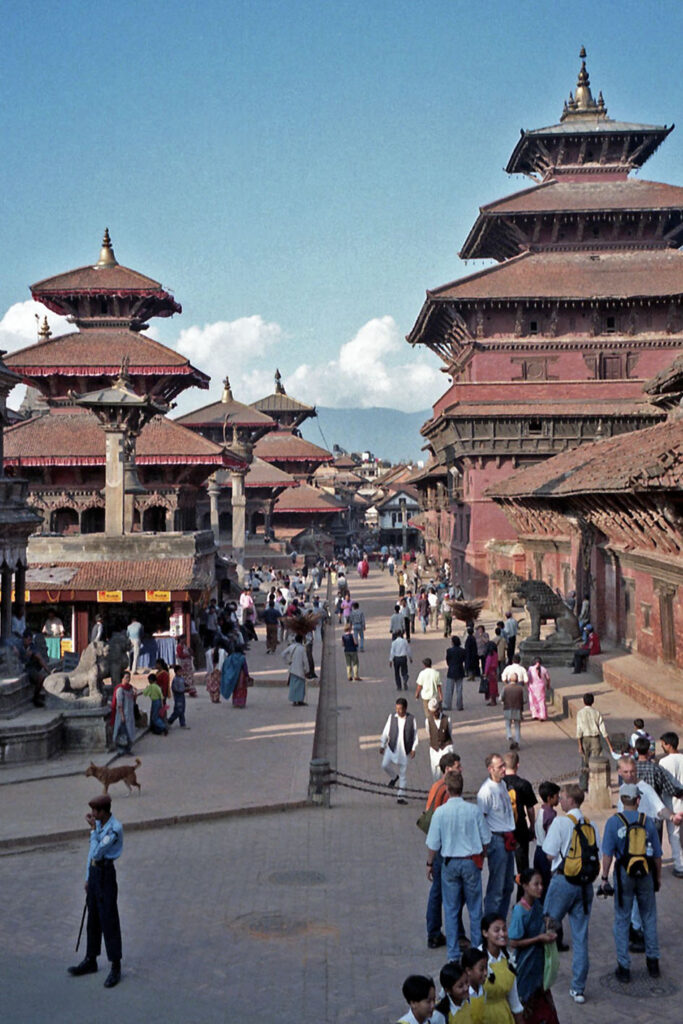
Pokara
It was a long 8 hour bus ride to Pokhara. Lots of narrow roads and deep gorges so best not to look out the side window. You are literally putting your life in the hands of the bus driver, you just hope they are an experienced driver. Pokhara is the starting place for treks to the Annapurna and Dhaulagiri district and is a crowded town full of bars, restaurants, clothes shops, tourists, hippies, trekkers and backpackers. There are lots of cows, oxen and dogs walking up and down the dirt and gravel roads. Nepalese workers were breaking rocks on the side of the road to make gravel out of large rocks, 70’s music blasting out from the bars, all types of weird and wonderful sights.
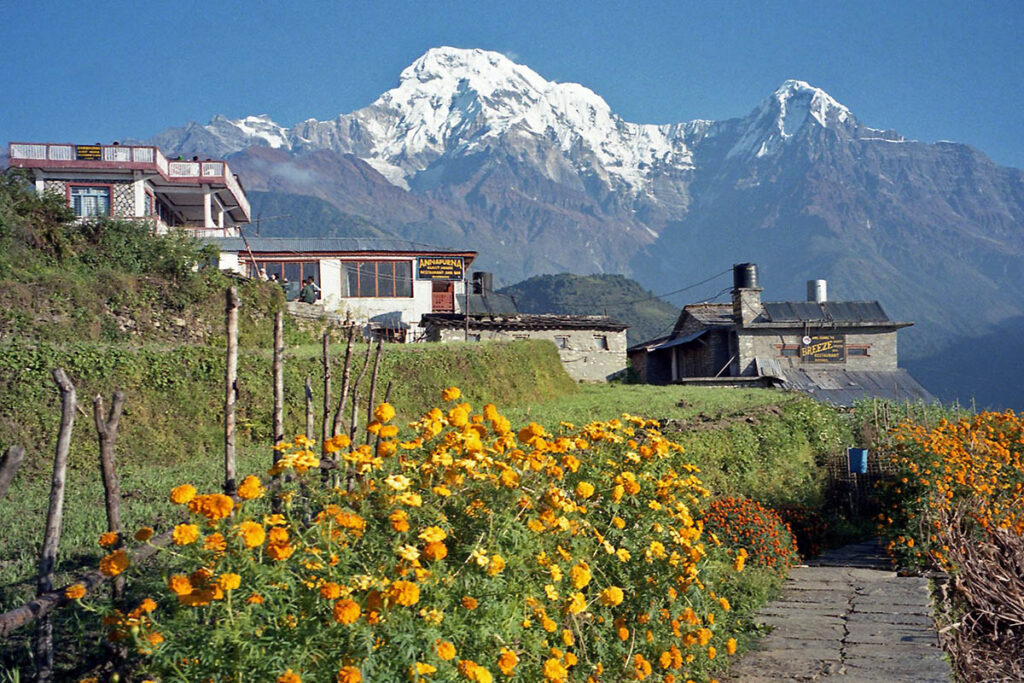
There were only six of us on the trek so logistically is was quite easy and no long queues for the toilet tent. Even so we had almost 20 Sherpas and porters for our group though some porters left towards the end of the trip to help other treks. The other single person was a female so I ended up with a tent to myself which was great. I can highly recommend World Expeditions (WE) as they are well organised and don’t cut corners. Sure you pay a premium on the trek price but you are well looked after and safety is a major factor to consider in Nepal. Accidents and death are not infrequent so it’s comforting to be with a well run organisation with experienced staff who know what they are doing – especially in an emergency. WE hire more porters per person for trekking than other groups and they have a fold up toilet seat inside the toilet tent (other groups didn’t have one in their toilet tent). Another advantage with an organised trip is that you get off the beaten track and away from the tea house trail where lots of tourists trek along well worn trails each year. We passed onto the tea house trail a couple of times and the wilderness atmosphere is diminished somewhat when you are constantly passing lots of tourists with their walking poles. The walking is hard work of course, more so at higher altitudes where there is less oxygen. You also need a fair bit of mental determination. Our first day of the trek was a tough introduction with six hours of walking that included passing through the “valley of the leeches” where you had to constantly pull the little buggers off your boots. Not a pleasant experience I must say but we only had one day of them in such large numbers. Then about half an hour from camp (Dhampas) it started pouring with rain and then rained heavily for most of the night. Luckily we had good weather for the rest of the trip. Our next two camping stops were at Landrung and Gandrung.
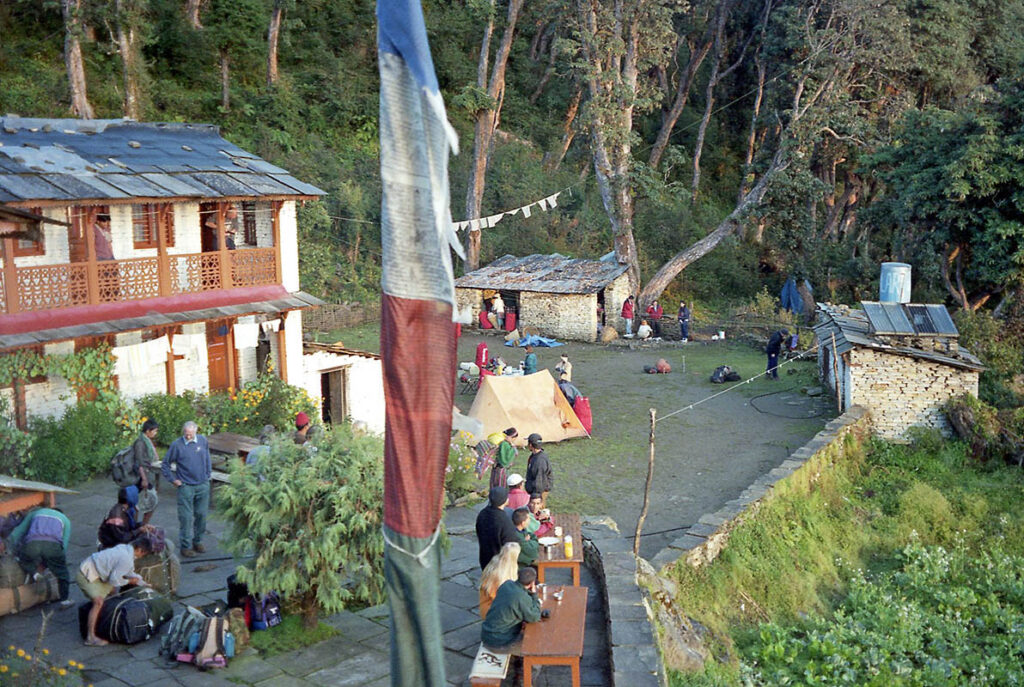
Life on the the trekking trail is made easier in that we didn’t have to do anything except eat, walk and sleep – you are waited on hand and foot by the support staff. The Sherpas would wake you up around 6am and serve a cup of tea, then they would bring a bowl of warm water for a hand wash. You would then have to pack your duffle bag before joining the others for breakfast. Breakfast would usually consist of porridge or muesli, Indian bread, jam and a small omelette. For lunch we would have hot cordial drink on arrival then curried veges, cabbage, tuna, lots of chips or spuds, bread, and fruit for desert. In the evenings they serve dinner in a dining tent complete with metal table and chairs. Yes, some poor porter has to carry them.

Most nights we had soup with lots of garlic and ginger plus papadoms. Yum. Initially they gave us popcorn with our soup. Not sure who would give them that culinary idea. Once the Chef knows you like something you get it all the time. The main meal would consist of some stew or pasta dish, salad, rice, lentil sauce, spinach, cauliflower, etc. Usually we had fruit for desert but sometimes a cake or special dish. We had a very good Chef on this trek so we certainly ate well that’s for sure. However, once you start getting above 3,000m you can lose your appetite and at times I had to force myself to eat as I knew I needed the energy for the next day’s walking. No beer or alcohol while ascending in altitude. Altitude sickness is a constant concern when trekking at high altitude. In fact an elderly guy in our party got sick before reaching 3,000 metres near Tadapani. He had a weak heart and was not feeling well on the morning he became sick. Unfortunately, he and his wife had to go back down to the village we had just left accompanied by one of the Sherpa’s. Another Sherpa went ahead and caught up with the porters to have their bags brought back down. We met up with them a few days later. The scenery on our trek was magnificent as we walked though lichen covered forests and remote villages, past shrines, buffalo, yaks, donkey trains, wild marijuana plants, Langur monkeys, people herding goats and sheep, along precarious ridge crossings, and of course the young children asking for pens and lollies (on the more touristy paths). Sometimes we even crossed creeks on man made bridges of rocks and logs.
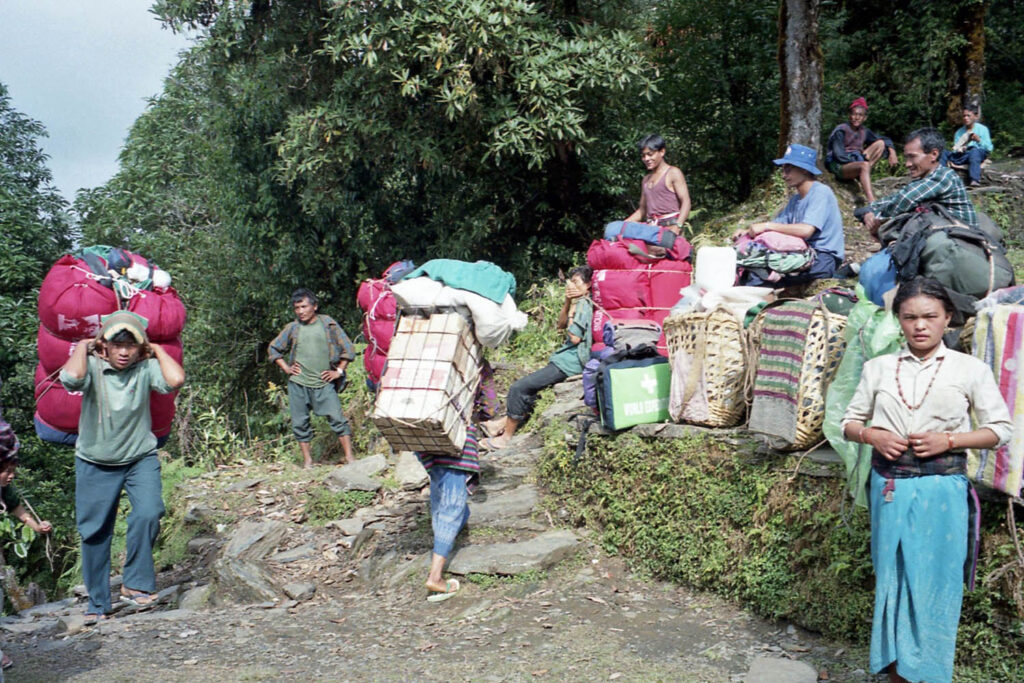
Do Bato and Christiburg
Our next two overnight camping spots were at Do Bato and Christiburg. We passed many landslides (due to heavy rainfalls) which tend to wipe out the path and everything else with it. We went past some lovely pine trees and then we climbed up past the tree line where only the grass can grow. The mountains are of course breath-taking and each day we got a bit closer to them and saw them at slightly different angles. The best time for photography is in the mornings as the clouds tend to roll in after lunch. At times we were able to glimpse the mountains at night in the moonlight when the clouds parted for a while. There is not much to do in the evening, you are pretty tired from the walking and early starts anyway, so most nights you are in bed by 7-30 or 8-30pm. I usually wrote up my diary and postcards after dinner underneath the kerosene lamp in the dining tent. Around the tea house trail they would leave a kero light on all night and one of the Sherpa’s would be on guard duty to ensure no thefts from our tents. The kitchen staff would always boil water at meal times so we could replenish our water bottles with drinking water. I had some Toblerone chocolate which came in handy during the trek in providing little boosts of energy.
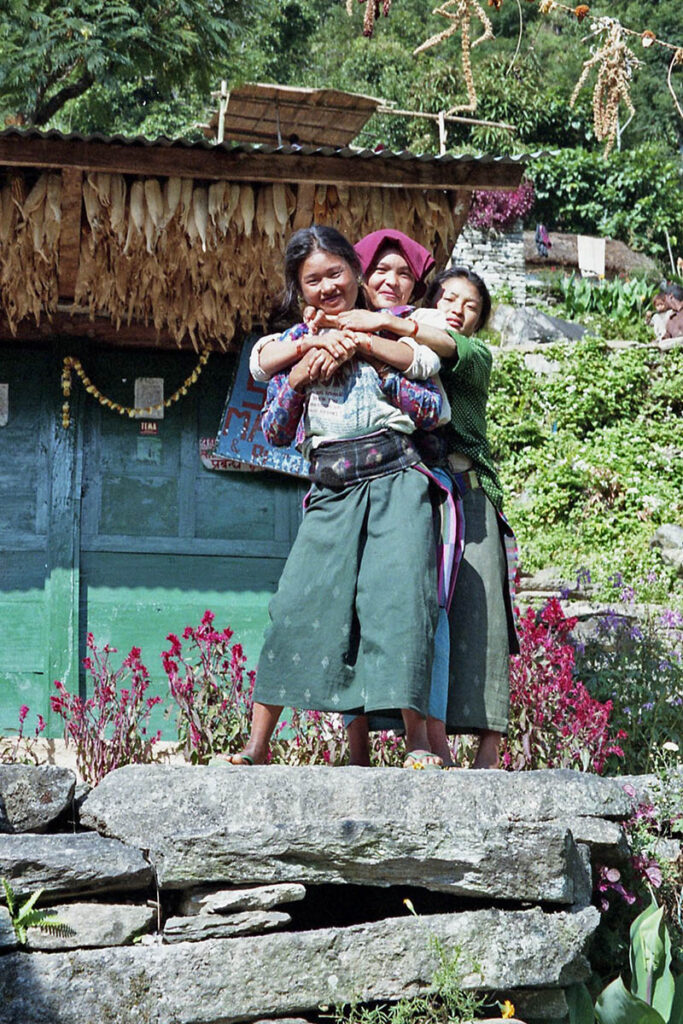
It got very cold at nights after we passed the 3,000 metre mark – especially at Do Bato. Some nights it reached up to -5 so you definately needed the feather down jacket and sleeping bag that World Expeditions provided. Some nights I even slept in the sleeping bag with the down jacket on. It’s a good way to stay warm but I felt like I was in straight jacket. I suspected we had a cold night when in the morning when I went to flip back the flaps on the tent fly and they were rock solid and covered in ice. I discovered that writing up my diary early in the morning is not a good idea as the fingers tend to freeze up so much you can’t write anything. It’s also interesting that at higher altitudes and in the cold it is harder to think. Quite a weird experience actually.
Kopra Ridge
Then we arrived at one of the highlights of our trek, Kopra Ridge. The ridge was nearly 4,000m and had a fantastic panorama of the surrounding mountains, including Dhaulagiri, Tukuche, Dhampus peaks, Nilgiris, Annapurna Fang, Annapurna South and Himchuli. Great stuff and clear sunny weather with very little wind so I managed to get some good photos. We also had some huge eagles majestically gliding above our camp. The trail to Jomson was way down below us and each day we would hear and or see planes and helicopters flying below us at lower altitudes.
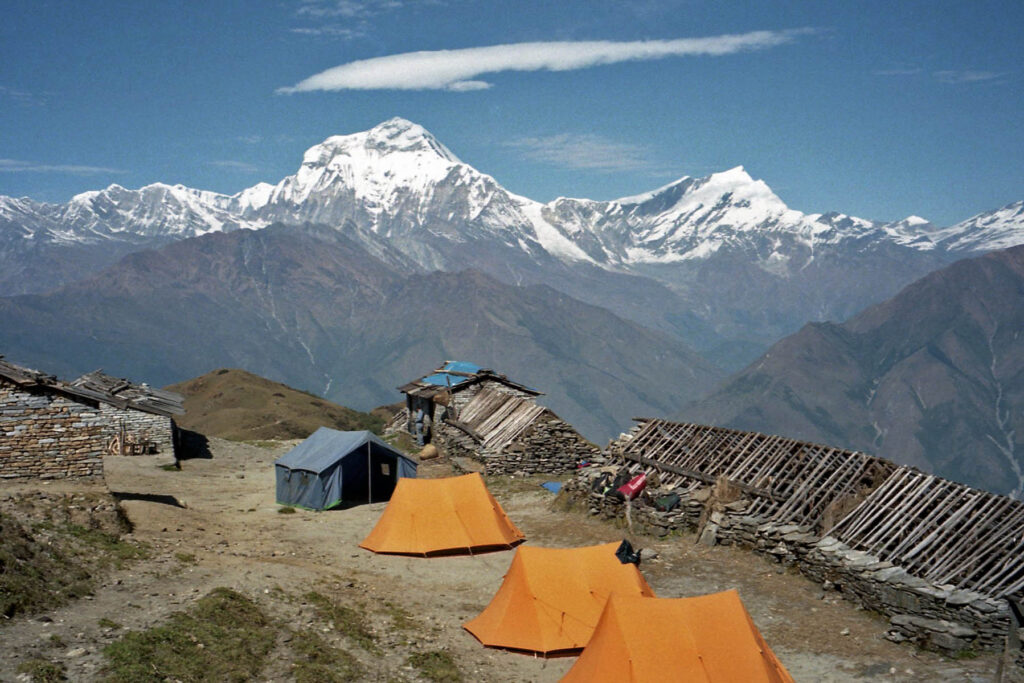
Khayer Lake
The next day we had the opportunity for an optional excursion to Khayer Lake. Two Sherpas, myself and Liz set out at 6am under moonlight and walked up to Khayer Lake (4,660m). Thanks to the quick pace set by our Sherpas it only took us 4 hours and 20 mins instead of the normal 5 hours 30 mins. The previous day, two thirds of a Peregrine group attempting the same climb didn’t make it due to altitude sickness and had to return back to Kopra Ridge. Our small expedition was successful though we did both suffer the affects of altitude sickness, Liz on the way up and myself on the way down. However, once you start descending the headache and nausea soon disappear. Your heart certainly works overtime on the way up and at times I felt like my head was going to explode as I could feel my temple pounding with the effort. While we were doing the hard yards, the rest of the group had a lazy day and wondered back down to the previous lower camp. The trek leader said he didn’t want to stay for two nights at such a high altitude. The leader has to look after not just us but the porters as well (several of whom were sick). We spent just under an hour at the lake having our packed lunch and taking photos. There were sheets of ice around the edges of the crystal clear lake. If we had another couple of hours we could have walked to the base of the glacier at Annapurna South, as we were just on the snow line.
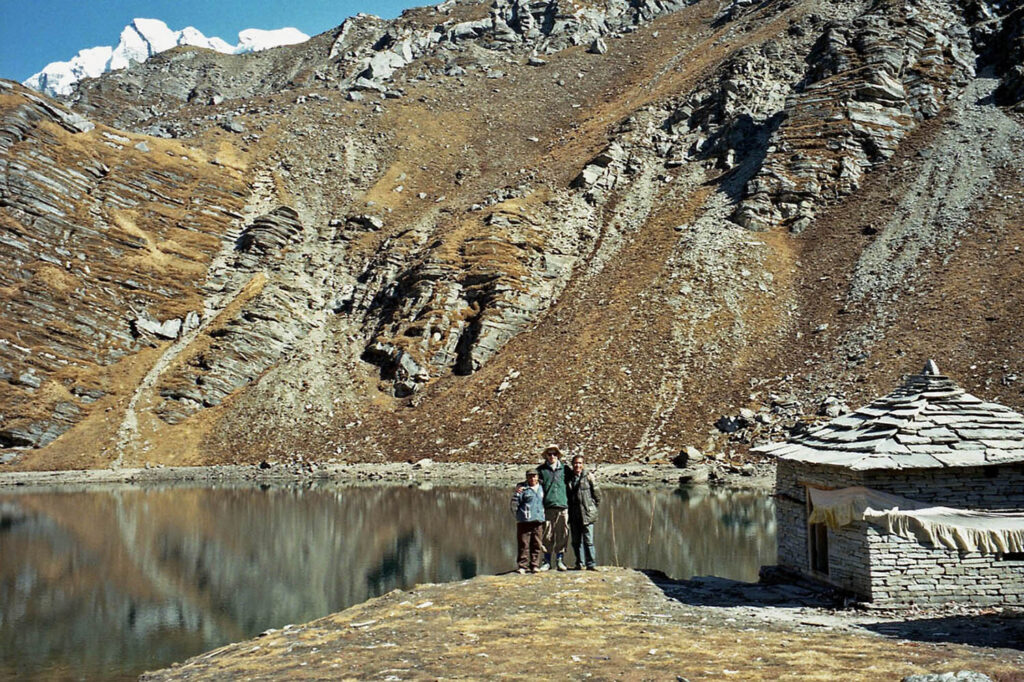
Then we had to descend nearly 2,000 metres as we walked down past Kopra Ridge to the previous camp at Christiburg and met up with the rest of the group. I was determined to carry my own day backpack all the way but about half way down I gave up as I was slowing down with the affects of altitude sickness and started to wonder whether I would actually make it back. So I gave my backpack to Hasta, one of our Sherpas, and that made it a lot easier for me. Liz was smart as she didn’t carry her backpack at all. We finally arrived at camp just before sunset and had been walking for over 10 hours so we were literally on our last legs. Actually one of the kitchen staff met us with some cordial about an hour from camp. Good intentions but it was the worse thing he could have done as it was so hard to start up again after a rest and my knees were ready to give way. Going down hill is actually just as hard as going uphill. We arrived to the cheers and congratulations of the other members of our trek and I was at last allowed to have a much earned Carlsberg beer or two. You beauty ! The beers went down rather well, even if they weren’t that cold.
Chitre and Ghorepani
It was all down hill after that day with an overnight stop at Chitre before meeting up with the other couple from our group the next day at Ghorepani. Our stay in Ghorepani coincided with a visit from the Minister for Tourism and so there was lots of music and dancing during the day and a cultural dancing event in the evening. The event was somewhat unorganised and the MC was a real hoot due to his unique interpretation of the English language. It was a very cold night and you had to feel sorry for the poor kiddies who were dancing in bare feet on the freezing cold cobble-stoned street. Our next overnight stops were at Ramch, Laspar and finally Naya-Pul.

Our Nepalese porters and Sherpas were terrific, very friendly and always happy. A couple of times we had singing and dancing sessions with the porters. Everyone would sit around in a big circle, someone would play the drums, the roxi (weak millet wine) would be passed around and then the singing would start. First the boys and then girls, each singing verses back and forth to each other. There were four female porters on the trek all from the same village and they had wonderful high pitched nasally voices, quite a unique sound and very pleasant when they finally stopped giggling and all sang at the same time. One morning one of the kitchen staff was obviously a bit tipsy as he was yelling out to us (we were following behind) and everyone else and carrying on a real treat. He wasn’t carrying anything but there were a couple of kitchen porters with him and they went down the wrong path to the right but then the drunk guy started yelling out to them and they came running back past the drunk guy, who was now laughing, and down the correct path. It reminded me a scene from Monty Python and our laughing just encouraged the drunk guy even more. This was the first trek for many of the porters so someone up front would draw arrows on the ground at intersecting paths to show the correct path to take. We all learnt a bit of Nepalese each day which we practised during meal times. Speaking a bit a Nepalese goes a long way as it puts the porters and Sherpas at ease. As this was the first trek for most of our crew they were initially quite shy. The Nepalese children we met along the way were an absolute delight, very curious and very photogenic. At Naya-Pul I had seven children sitting with me on a huge boulder while I wrote up my diary.

Back to Pokhara
We arrived back at Pokhara for our last night of the trek and the cook put on a huge dinner for us and there was much singing and dancing. The celebrations included handing out our tip money and unwanted clothing to the Sherpas and porters. Then it was back to Kathmandu on a small “Bhudda Air” plane where everyone gets a window seat. There was some turbulence during the flight which made it rather difficult for the hostess to pour the pepsi from the bottle into the plastic cups. Liz got her drink in her lap. I was very relieved to get back down on the ground. I had a couple of more days in Kathmandu before flying out to New Delhi for the second leg of my trip to India. The chaos continued at Kathmandu airport as there was this huge queue of people just to get into the airport and through the x-ray machines. No wonder they say get to the airport 3 or 4 hours before your flight is due to leave. I would love to go back to Nepal, perhaps next time I will trek in the Everest region. Namaste.
